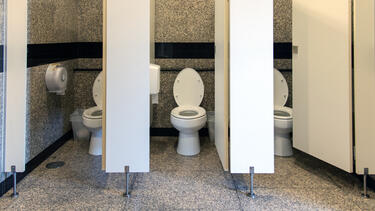Wastewater Can Reveal How Many of Us Have Gotten COVID-19
In a series of studies since 2020, a Yale team has shown that measuring COVID-19 RNA in sewage can provide insights into the course of the pandemic. New research based on wastewater data suggests that many more people had been infected with COVID-19 by May 2021 than official case counts indicated.

Since the early weeks of the COVID-19 pandemic in the United States, a group of Yale researchers has diligently tracked the virus via a useful but decidedly unglamorous source: sewage.
Daily measurements from the New Haven wastewater treatment facility have yielded a series of important insights about the pandemic’s course. In one study, a group of Yale researchers including Yale SOM’s Edward H. Kaplan, a professor of operations research, public health, and engineering, and Jordan Peccia, professor of chemical and environmental engineering, demonstrated that the concentration of COVID-19 RNA per milliliter of sewage sludge rises and falls with the rate of infection seen in testing and hospitalization data. In another, they found that testing wastewater can provide an early warning sign of a worsening outbreak, three to five days before hospitalizations begin to surge.
Now they’ve uncovered yet another secret in the sludge. In their latest paper, Kaplan, Peccia, and Yale student coauthors Alessandro Zulli and Marcela Sanchez use wastewater data to calculate the cumulative COVID-19 incidence rate in New Haven and present a formula that would allow other municipalities to do the same. Their results suggest that nearly a third of people in the New Haven area had been infected by May 2021—a finding that is consistent with three other independent statistical estimates, but notably larger than the 12% figure derived from official case counts.
To develop their estimate, Kaplan and Peccia needed just one reliable measure of how many people had been infected against which to calibrate their wastewater measurements. They were fortunate to have data from the Centers for Disease Control, which conducted antibody blood testing in Connecticut in the summer of 2020. That CDC testing, which took place before the arrival of vaccines, told the researchers how many people had been infected up to that point. After matching the CDC’s estimate with the concentration of RNA in wastewater at the same time, they could extrapolate forward to May 2021.
Any city could, in theory, do the same, whether using CDC data from the area or antibody tests from another source. “The principle is what’s important,” Kaplan explains. With frequent sewage data and one accurate point-in-time estimate of infections, the same basic approach can work anywhere.
Knowing how many people have been infected with COVID-19 over time “is important to knowing what our actual immunity to SARS-CoV-2 could be,” Peccia explains—but getting a good grasp on the cumulative incidence rate has proved challenging. (The CDC antibody tests from 2020 were helpful but not nationally representative and quickly fell out of date.)
Official case counts, which are derived from testing, reflect inconsistencies in testing across the U.S. Early in the pandemic, tests were scarce; more recently, the widespread use of at-home tests means that not every positive result is being reported to public health authorities as a new case of COVID-19. Trying to reverse engineer the number from other signals, such as hospitalizations, is equally tricky: some variants have put more people in the hospital than others.
Where tests and other measures fail, toilets succeed. People who contract COVID-19 go to the bathroom whether or not they get tested, making wastewater one of the few direct, population-level sources of information about the pandemic’s ebb and flow.
But where tests and other measures fail, toilets succeed. People who contract COVID-19 go to the bathroom whether or not they get tested, making wastewater one of the few direct, population-level sources of information about the pandemic’s ebb and flow. “How many infections are happening? That’s the hidden thing that you want to see,” Kaplan says. “We believe the wastewater signal is giving us the very best view of that.”
In New Haven, the incidence rate derived from sewage suggests “there’s a lot of immunity out there,” Peccia says. “We’re not all as vaccinated as we should be and not as boosted as we should be, but there’s a lot of people that have been infected. If you just go back and you look at [case counts], you’ll really underestimate that.”
Kaplan and Peccia are quick to point out that wastewater monitoring, for all its merits, is no substitute for testing. After all, “you can’t do contact tracing off of wastewater,” Kaplan says. Tests help individuals know whether to isolate and allow public health officials to link cases to vaccination status, for instance. But testing programs are also very expensive, and as the pandemic stretches on, “we’re going to need to augment them in some way.”
Wastewater monitoring offers a powerful and economical complement to a conventional COVID-19 testing program. In addition to calculating cumulative incidence rates, wastewater data makes it possible for officials to spot emerging outbreaks. Kaplan cites the example of Norwich, Connecticut, which used wastewater data to identify a cluster of cases and intervene before it spread further.
Kaplan and Peccia also see potential in sewage-based monitoring for diseases beyond COVID-19. They’re in the early stages of studying influenza in New Haven; wastewater has previously been used to track polio in the developing world. The work they and others have been doing, Peccia says, “lays the groundwork for many, many other types of viruses.”